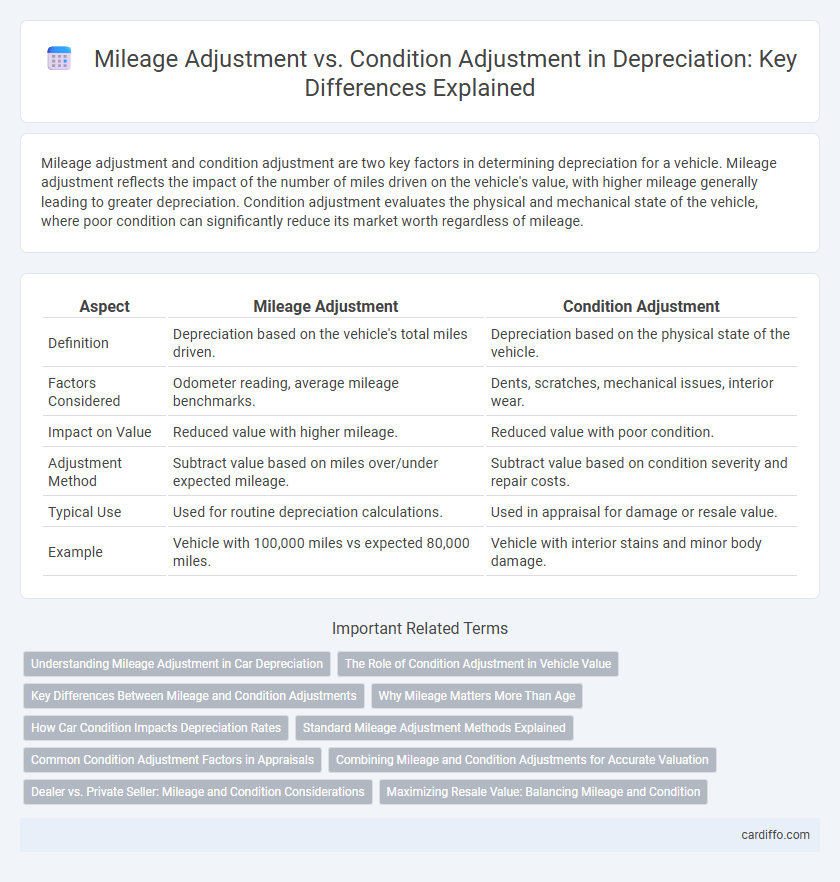Mileage adjustment and condition adjustment are two key factors in determining depreciation for a vehicle. Mileage adjustment reflects the impact of the number of miles driven on the vehicle's value, with higher mileage generally leading to greater depreciation. Condition adjustment evaluates the physical and mechanical state of the vehicle, where poor condition can significantly reduce its market worth regardless of mileage.
Table of Comparison
| Aspect | Mileage Adjustment | Condition Adjustment |
|---|---|---|
| Definition | Depreciation based on the vehicle's total miles driven. | Depreciation based on the physical state of the vehicle. |
| Factors Considered | Odometer reading, average mileage benchmarks. | Dents, scratches, mechanical issues, interior wear. |
| Impact on Value | Reduced value with higher mileage. | Reduced value with poor condition. |
| Adjustment Method | Subtract value based on miles over/under expected mileage. | Subtract value based on condition severity and repair costs. |
| Typical Use | Used for routine depreciation calculations. | Used in appraisal for damage or resale value. |
| Example | Vehicle with 100,000 miles vs expected 80,000 miles. | Vehicle with interior stains and minor body damage. |
Understanding Mileage Adjustment in Car Depreciation
Mileage adjustment in car depreciation quantifies the impact of a vehicle's actual miles traveled compared to the expected mileage allowance, influencing its market value. Higher mileage typically accelerates depreciation due to increased wear and tear, while lower mileage can preserve or enhance resale value. This adjustment differs from condition adjustment, which assesses physical and mechanical state, emphasizing mileage as a key factor in depreciation calculations.
The Role of Condition Adjustment in Vehicle Value
Condition adjustment plays a crucial role in vehicle value by directly reflecting the physical state and maintenance history of the car, which significantly impacts its market price. Unlike mileage adjustment that mostly considers distance traveled, condition adjustments account for wear and tear, cosmetic damages, or mechanical issues, providing a more comprehensive valuation. Accurate condition assessment ensures fair depreciation calculations, ultimately influencing resale price and buyer confidence.
Key Differences Between Mileage and Condition Adjustments
Mileage adjustment quantifies depreciation based on the number of miles driven, directly correlating wear with distance, while condition adjustment evaluates the physical state of the asset, considering factors like damage, maintenance, and overall appearance. Mileage adjustments rely on standardized mileage schedules and market data, whereas condition adjustments require detailed inspections and expert assessments to determine leftover value. The primary difference lies in mileage adjustment addressing usage intensity, whereas condition adjustment focuses on qualitative asset health beyond mere distance traveled.
Why Mileage Matters More Than Age
Mileage matters more than age in depreciation calculations because it directly reflects the actual usage and wear of a vehicle, impacting its mechanical condition and resale value more accurately than age alone. High mileage typically indicates greater wear and potential for repairs, leading to a larger reduction in value, whereas an older vehicle with low mileage may retain more of its worth. Condition adjustments factor in physical and functional state, but mileage adjustment provides a quantifiable metric that better predicts the vehicle's remaining lifespan and maintenance needs.
How Car Condition Impacts Depreciation Rates
Car condition significantly influences depreciation rates by directly affecting a vehicle's market value and resale price. Poor condition, such as visible wear, mechanical issues, or damage, accelerates depreciation beyond standard mileage adjustments by reducing buyer demand and perceived reliability. While mileage adjustment accounts for use-related wear, condition adjustment reflects the vehicle's actual state, often causing larger depreciation if maintenance and repairs are neglected.
Standard Mileage Adjustment Methods Explained
Standard mileage adjustment methods calculate depreciation by estimating vehicle wear based on miles driven, using benchmarks like the IRS mileage rate of 58.5 cents per mile for business wear and tear. Condition adjustments assess physical damage, mechanical issues, and overall vehicle state, independent of mileage, often requiring professional inspection. Mileage adjustment offers a quantitative approach to depreciation, while condition adjustment provides a qualitative evaluation, both essential in accurate vehicle valuation.
Common Condition Adjustment Factors in Appraisals
Common condition adjustment factors in appraisals include vehicle wear and tear, cosmetic damages, and mechanical issues, which directly impact value depreciation. Mileage adjustment typically quantifies depreciation based on the distance driven, while condition adjustment accounts for physical and operational status deviations from market standards. Accurate appraisals rely on balancing both factors, emphasizing the importance of condition assessments such as tire wear, interior damage, and service history.
Combining Mileage and Condition Adjustments for Accurate Valuation
Combining mileage adjustment and condition adjustment ensures a more precise vehicle depreciation valuation by accounting for both the actual distance driven and the physical state of the vehicle. Mileage adjustment quantifies value loss based on miles traveled, whereas condition adjustment reflects wear and damage, both significantly impacting resale value. Using both metrics together allows appraisers to provide a comprehensive and accurate market valuation.
Dealer vs. Private Seller: Mileage and Condition Considerations
Mileage adjustment typically varies more significantly between dealer and private seller transactions, with dealers often applying stricter mileage thresholds impacting vehicle valuation. Condition adjustment tends to be more subjective, where dealers rely on detailed inspections and standardized grading systems, while private sellers may underreport or overlook wear and tear. Understanding these differences helps buyers and sellers navigate price negotiations based on accurate depreciation factors linked to mileage and vehicle condition.
Maximizing Resale Value: Balancing Mileage and Condition
Maximizing resale value requires a strategic balance between mileage adjustment and condition adjustment, as both significantly impact depreciation rates. Lower mileage reduces overall depreciation, but maintaining excellent condition can offset higher mileage by preserving vehicle appeal and functionality. Optimizing both factors enhances market competitiveness, ensuring the vehicle retains value longer and attracts a broader pool of buyers.
Mileage Adjustment vs Condition Adjustment Infographic

 cardiffo.com
cardiffo.com